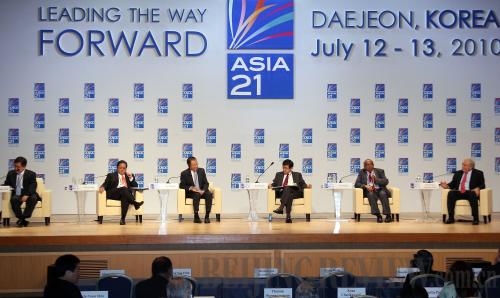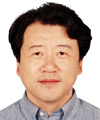|
 |
|
ATTENTION ON ASIA: Participants hold a panel discussion at the high-level "Asia 21: Leading the Way Forward" conference in Daejeon, South Korea, on July 12 (CFP) |
 |
|
(COURTESY OF SHI YONGMING) |
On July 12-13, the high-level conference "Asia 21: Leading the Way Forward" was jointly hosted by the International Monetary Fund (IMF) and the South Korean Government in Daejeon, South Korea. The importance the IMF attaches to Asia shows the role of Asia-Pacific economic development within the global framework has increased dramatically since the outbreak of the global financial crisis in 2008.
The crisis, triggered by the U.S. subprime mortgage crisis, severely impacted global financial markets. As a result, East Asian countries' export sectors were badly hit by shrinking consumer markets in Europe and the United States.
Although East Asian countries led the way out of the crisis and maintained rapid growth, the impact of the crisis revealed various new challenges their economic development models now face. How to deal with these challenges is crucial to maintaining sustained and rapid economic growth in the region.
Export bottlenecks
The development paths of East Asian countries are different, but generally speaking, they are all countries playing catch-up, as they lag behind European and U.S. economies.
Japan and South Korea took advantage of U.S. support during the Cold War, and realized economic catch-up through promoting technological advancement. In the meantime, exports played a significant role in their economic development as well.
Other countries mainly adopted export orientation as a way to catch up, despite some import substitution strategies—because an export-oriented economy not only adapts to the international division of labor in the context of economic globalization, but can also solve problems of capital and technology shortages in less developed countries.
Since the 1980s, Japan has led the pack in East Asian economic growth. The Japan-led model aimed at establishing a regional division of labor, making use of the differences in East Asian nations' development levels. It has created a regional export-oriented economy, featuring dependence of the region's overall development on exporting to countries outside the region.
But, with the region's economic growth, this development model began to suffer from bottlenecks, as evidenced in the export-oriented manufacturing sector.
Export-oriented economies can develop rapidly in their early stages through the use of their cheap labor resources as well as foreign capital, technologies and markets.
But with their expansion, the driving force provided by exports will inevitably decline. There are several reasons for this. First, due to low added value, manufacturing for export can only make profits by selling a large quantity of products. But it is difficult to increase dramatically once a certain level is reached.
In addition, manufacturing industries are mostly labor-intensive. When an economy develops to a certain level, human resource costs will rise, thus undermining industrial advantages.
What's more, if a country's economic growth depends on export-oriented manufacturing in the long term, it will be restrained by changes in external economic environments, and it will become difficult to achieve sustained growth.
| 